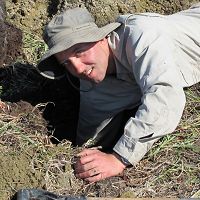Driscoll et al., 2014
The Role of Dynamic Storage in the Response to Snowmelt Conditions in the Southwestern United States: Flux Hysteresis at the Catchment Scale
Driscoll J., Meixner T., Ferré T., Williams M., Sickman J., Molotch N., Jepsen S. (2014)
Abstract H51O-0825 presented at 2014 Fall Meeting, AGU, San Francisco, CA, 15-19 Dec. Cross-CZO
-
Catalina-Jemez, GRAD STUDENT
-
Catalina-Jemez, INVESTIGATOR
-
Catalina-Jemez, INVESTIGATOR
-
Boulder, INVESTIGATOR
-
Boulder, Sierra, INVESTIGATOR
-
Sierra, COLLABORATOR
Abstract
The role of dynamic storage in catchment discharge response to earlier snowmelt timing has not been fully quantified. Green Lake 4 (GL4) and Emerald Lake Watershed (ELW) have similar high-elevation settings but GL4 has greater estimated storage capacity relative to ELW due to differences in physical structure. Daily catchment area-normalized input (modelled snowmelt estimates) and output (measured discharge) in conjunction with mineral weathering products (hydrochemical data) for eleven snowmelt seasons from GL4 (more storage) and ELW (less storage) were used to determine the role of dynamic storage at the catchment scale. Daily fluxes generally show snowmelt is greater than discharge initially, changing mid-season to discharge being greater than snowmelt, creating a counter-clockwise hysteresis loop for each snowmelt season. This hysteresis loop can be approximated with a least-squares fitted ellipse. The properties of fitted ellipses were used to quantify catchment response, which were then compared between catchments with different storage capacities (GL4 and ELW). The eccentricity of the fitted ellipses can be used to quantify delay between snowmelt and discharge due to connection to subsurface storage; narrower loops show minimal storage delay whereas wider loops show greater storage delay. Variability of mineral weathering products shows changes in contribution from stored water over the snowmelt season. Both catchments show a moderate linear correlation between fitted ellipse area and total snowmelt volume (GL4 R2=0.516, ELW R2=0.614). Ellipse eccentricity is more consistent among years in ELW (range=0.81-0.94) than in GL4 (range=0.54-0.95), indicating a more consistent hydrologic structure and connectivity to shallow storage at ELW. The linear correlation between seasonal eccentricity versus snowmelt timing is stronger in ELW than GL4 (R2=0.741 and 0.223, respectively). ELW shows hydrochemical response independent of snowmelt timing, whereas GL4 shows more variability. The larger storage capacity of GL4 allows for a greater range of physical and chemical response to input conditions. The limited storage capacity of ELW shows greater vulnerability of physical response to changes in snowmelt conditions, though chemical response remains constant regardless of snowmelt conditions.
Citation
Driscoll J., Meixner T., Ferré T., Williams M., Sickman J., Molotch N., Jepsen S. (2014): The Role of Dynamic Storage in the Response to Snowmelt Conditions in the Southwestern United States: Flux Hysteresis at the Catchment Scale. Abstract H51O-0825 presented at 2014 Fall Meeting, AGU, San Francisco, CA, 15-19 Dec..
 This Paper/Book acknowledges NSF CZO grant support.
This Paper/Book acknowledges NSF CZO grant support.
Explore Further







